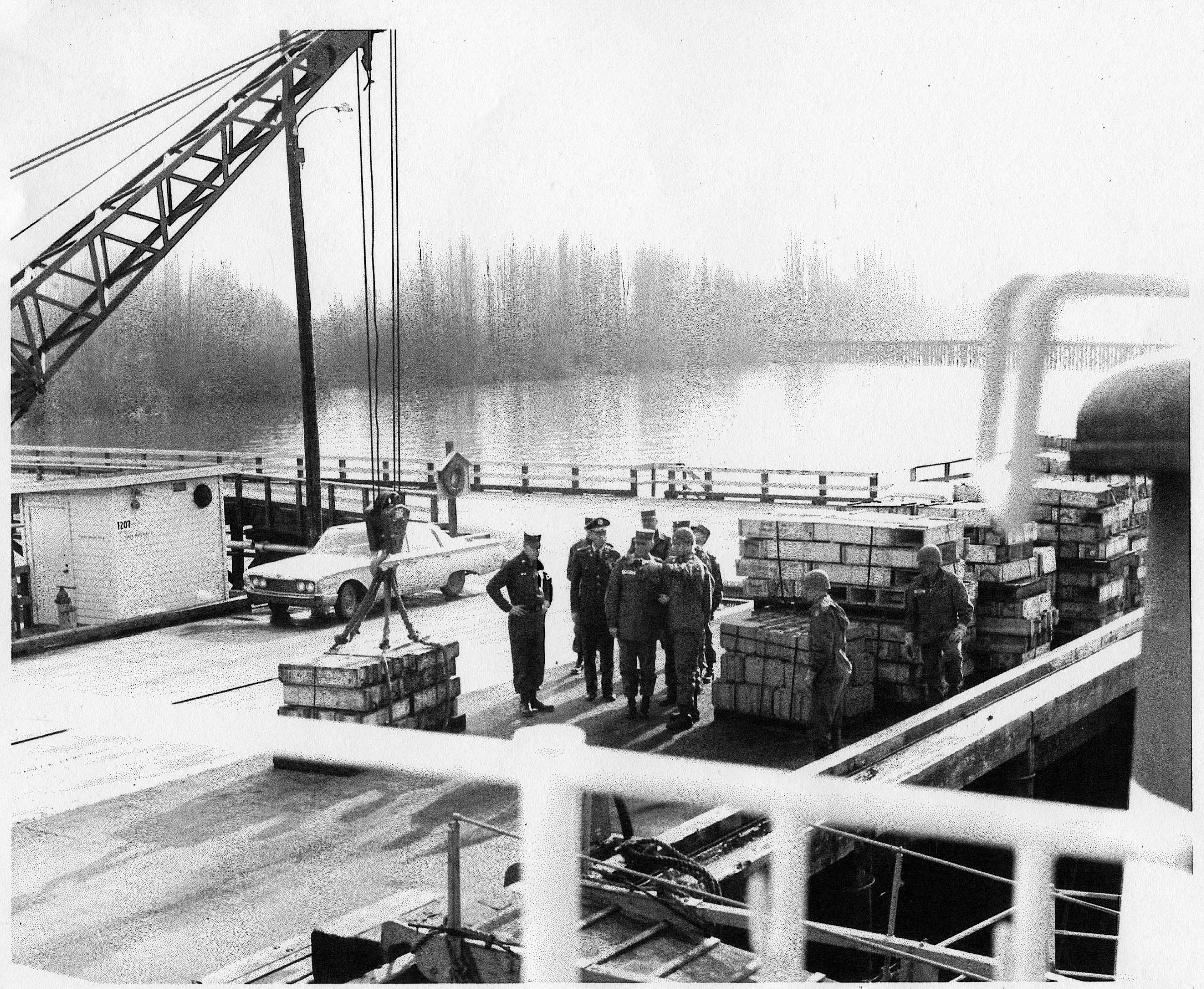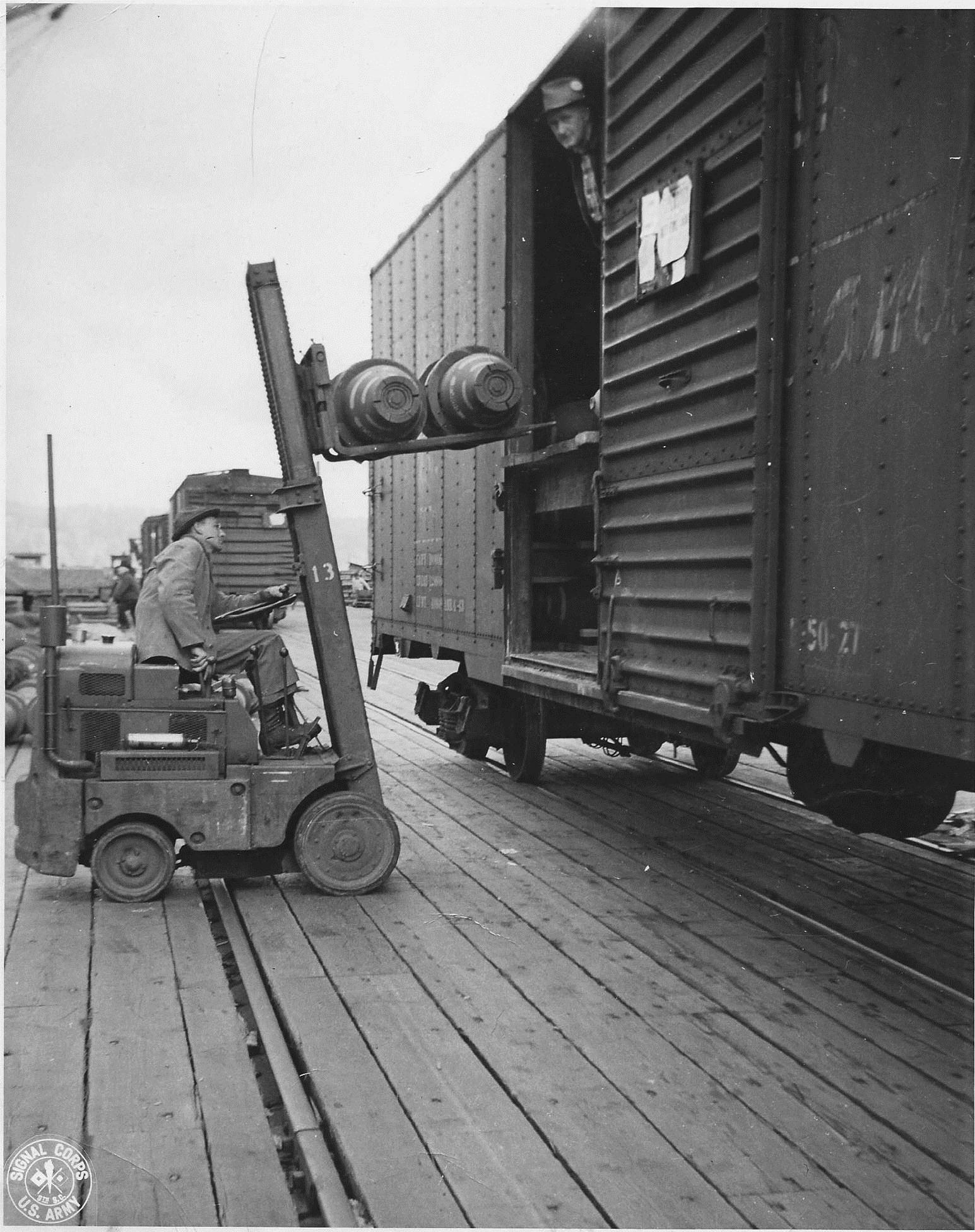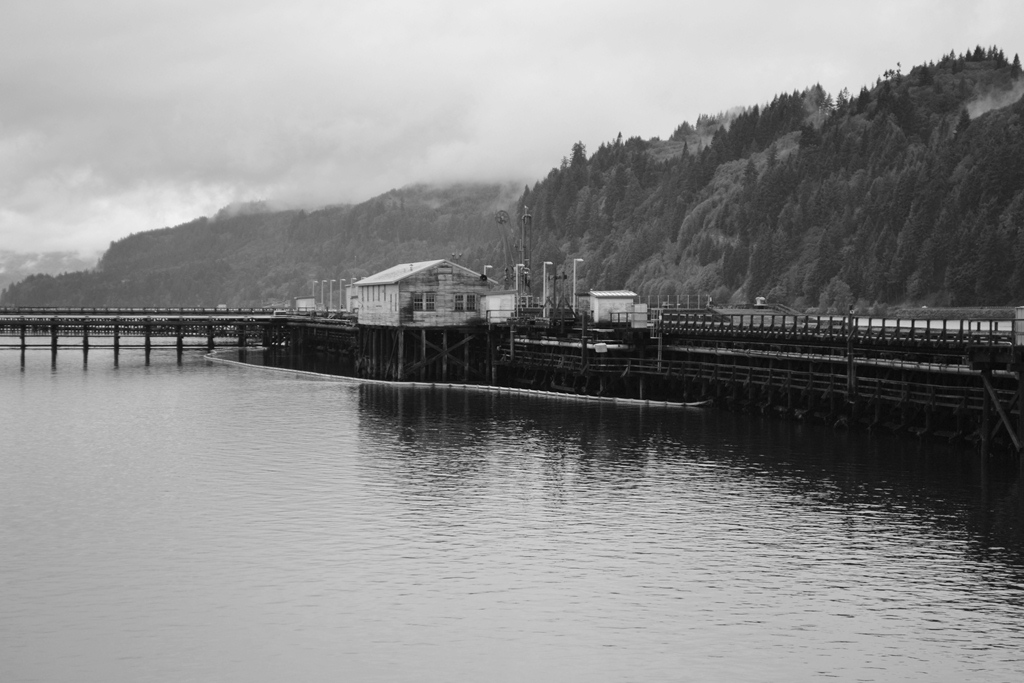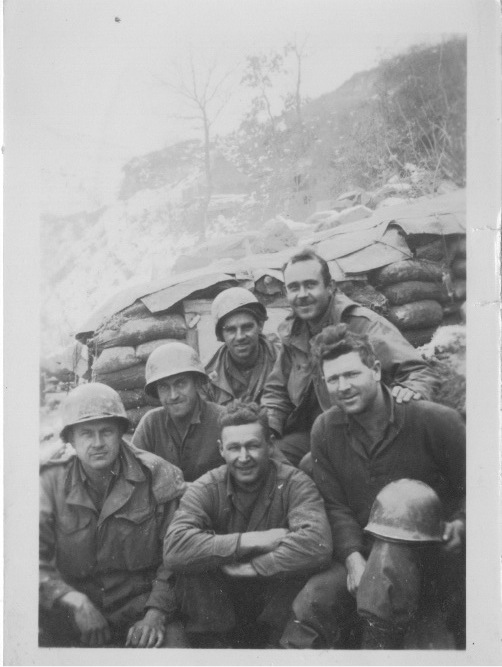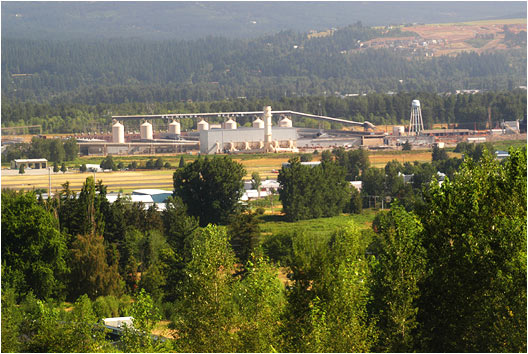The Beaver Ammunition Storage Point Depot (BASP) was located at Port Westward on the south bank of the Columbia River, near Clatskanie. The terminal and a large wooden dock and railroad trestle were built in early 1942. The large military storage facility was a shipping point for transloading ammunition during World War II and the Korean Conflict. Renamed the Beaver Army Terminal in 1955, the installation closed in 1964.
Planning and construction of the BASP began within weeks of the Japanese bombing of the U.S. naval base at Pearl Harbor. Building the depot meant displacing nine Finnish dairy farmers and their families, who had to move their livestock and quickly find new places to live. News of the depot's construction was top secret, and the local newspaper, the Clatskanie Chief, was prohibited from reporting on it.
The Portland District of the U.S. Army Corps of Engineers was responsible for construction and also the “supervision of loading and scheduling of military shipments” from the depot. In addition to the large dock, the Corps built a railroad trestle, laid eleven miles of track, and constructed ninety-two buildings, most of them temporary wood-framed barracks, administration buildings, and Quonset huts. The permanent structures included twenty storage igloos and two concrete bomb shelters. Each 26-by-18-foot igloo was made of poured concrete covered with an earthen berm.
The BASP officially opened on August 17, 1942, under the command of 1st Lt. Frederick G. Battenslag. During the first months of operation, munitions of TNT arrived from the Kankakee (Illinois) Ordnance Works to be loaded onto Russian ships for use in the European Theater of Operations, and American and British ships were loaded with ammunition and high explosives for the wars in Europe and the Pacific.
At the depot, workers unloaded railcars containing TNT, shells, charges, ammunition, and trucks onto vessels waiting at the dock. Union longshoremen and Seabees handled the ammunition and explosives, which were carefully regulated and monitored. When the men handled chemical ammunition, for example, they wore gas masks and protective clothing and always had testing equipment on hand. They were well aware of what they were handling and its importance to the war effort. Near the end of the war, unused ammunition, including that captured from the Japanese, was unloaded at the depot and shipped elsewhere. The BASP was deactivated on May 31, 1946, and put on inactive standby status in 1947.
The Beaver Ammunition Depot was reactivated on August 28, 1950, not long after the beginning of the Korean Conflict. Under the command of Col. Leo Hofinger, the base once again was used as a shipping point for munitions. At the time, there were only three military ports shipping ammunition in the country: the Beaver Depot, Port Chicago at San Francisco, and a third on the East Coast in New York. The U.S. Army briefly closed the facility at Clatskanie in September 1952 after an evaluation reported that the proximity of the facility to civilian residences was unsafe. After the closure, the dock was used for the wet storage of army craft, and it briefly reopened in 1953 for ammunition transport.
In 1955, the depot was renamed the Beaver Army Terminal and was reassigned to the U.S. Army Supply and Material Command to receive, store, and prepare shipments of equipment and spare parts. Barges were tied up on the Bradbury Slough side of the facility, and amphibious landing craft were parked in a dry storage area, a strip of land that paralleled the slough. Barge derricks were repaired on site. The depot was maintained, the Clatskanie Chief reported in 1953, as the “only facility on the West Coast for outloading of ammunition…in the event of an emergency.”
The Beaver Army Terminal was a major employer in Clatskanie until it was closed in 1964 as part of the Defense Department's cost-cutting efforts. The 103 civilians whose positions were terminated were given the opportunity to move to other civil service jobs, although most chose to remain in the area. On July 22, 1964, the Oregonian reported that “some 150 barges, floating cranes, landing craft and tug boats” stored at the terminal had been shipped to facilities in California.
The government declared the property surplus and in January 1965 turned it over to the General Services Administration for disposal. The Port of St. Helens, with the support of government officials and local voters, received title to the property in 1966. All that remains of the installation are portions of the railroad trestle and the large cargo dock, which have been used for industrial purposes for more than seventy years.
-
![]()
Aerial view of the Beaver Army Terminal, November 1956.
Courtesy U.S. Army Corps of Engineers
-
![]()
Loading cargo at the west end of the Beaver Army Terminal Dock, 1962.
Courtesy Clatskanie Historical Musuem, U.S. Army photograph
-
![]()
Amphibious vehicles lined up at the Beaver Army Terminal, 1962.
Courtesy Clatskanie Historical Musuem, U.S. Army photograph
-
![]()
Unloading munitions at the Beaver Army Terminal Dock during World War II.
Courtesy of Clatskanie Historical Museum
-
Beaver Army Terminal Dock, looking north, 2014.
Courtesy Elizabeth J. O'Brien
Related Entries
-
![Camp Abbot]()
Camp Abbot
Camp Abbot, located on the Deschutes River several miles south of Bend,…
-
![Camp White]()
Camp White
Camp White, a U.S. Army Cantonment, was built on the Agate Desert, near…
-
![Fort Stevens]()
Fort Stevens
One of the three major forts designed to protect the mouth of the Colum…
-
![Kaiser Shipyards]()
Kaiser Shipyards
During World War II, industrialist Henry J. Kaiser established three sh…
-
![Troutdale Aluminum Plant]()
Troutdale Aluminum Plant
In November 1941, bulldozers advanced into the green meadows of the Sun…
-
![Umatilla Army Depot]()
Umatilla Army Depot
In 1940, the U.S. Army identified twenty thousand acres straddling the …
Related Historical Records
Map This on the Oregon History WayFinder
The Oregon History Wayfinder is an interactive map that identifies significant places, people, and events in Oregon history.
Further Reading
Supply and Maintenance. Army Research and Development Newsmagazine 3:8 (1962): 4.
FY 1963 MCA Program Summary. Headquarters, Beaver Depot Activity, Clatskanie, Oregon, 1960. National Archives, Seattle.
Blaeuer, Samuel D. Department of the Army, Submitted by Office, Chief of Engineers, Real Estate, Disposal Report No. 1883, 1964. National Archives, Seattle.
Deane, Early. “Closure of Clatskanie Army Terminal to Kill 103 Jobs.” Sunday Oregonian, April 26, 1964, 38.
Knott, Lawson B. Jr. Memorandum: Submission of Proposed Negotiated Sale, Beaver Army Terminal, Clatskanie, Oregon, 1965. National Archives, Seattle.
Kuranda, Kathryn M. et al. Historic Context for Department of Defense Facilities, World War II Permanent Construction. Frederick MD: Christopher Goodwin & Associates, 1997.
Larsen, E. M. Memorandum: Standard Operating Procedure for the Handling of Ammunition and/or Explosives on the Dock. Army Service Forces, Beaver Ammunition Storage Point, Clatskanie, OR, 1945. National Archives, Seattle.
O’Brien, Elizabeth J., and Judith A. Chapman. Beaver Army Terminal Dock Historic Structure Documentation, Port Westward, Columbia County, Oregon. Archaeological Investigations Northwest, Report No. 3404, 2015. Prepared for CPBR Global Companies, Clatskanie, and the Port of St. Helens.
Olsen, A. G. Disposal Plan, Submitted pursuant to H. B., Excess and Surplus Real Property, 1965. National Archives, Seattle.
Clatskanie Chief, January 11, 1946; September 1, 1950; December 1, 1950; August 17, 1962; August 24, 1962; January 29, 1965.
Oregonian, July 22, 1964.
U.S. Army Corps of Engineers. Inspection Report, Beaver Army Terminal, Clatskanie, Oregon. D-Ore-408, 1962. National Archives, Seattle.
Willingham, William F. Army Engineers and the Development of Oregon: A History of the Portland District U.S. Army Corps of Engineers. Portland: U.S. Army Corps of Engineers, Portland District, 1992.


